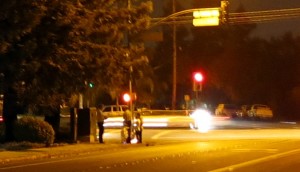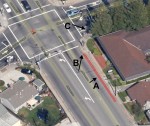Yesterday morning, on our way to the shop, my daughter (Becky) and I saw that Alameda was closed off at Jefferson, with two police cars, police tape, and, as we looked a bit closer, a bicycle pushed up against the curb. My heart sank. As we continued on Jefferson, it sank even more when we came across a large flatbed with a truck on it, followed by a police car.

It was some time before there were any news reports I could find on the accident, but eventually google came up with what I feared. A 14 year old girl, on her way to school (Woodside High), died in an incident with a truck. Both car and cyclist were making the same right-hand turn. You can view the intersection here, in Google street view. There are no sight line issues here, nothing to obscure the view of a cyclist making a turn in front of you. If that’s what happened; we know that both the motorist and the young girl were heading in the same direction, eastbound, on Jefferson, and both made the same turn, right, onto Alameda.
We don’t know if the truck had previously passed the cyclist prior to arriving at Alameda, with the cyclist then squeezing in between the curb and truck, taking an inside line to get ahead of it. This seems pretty unlikely, but it’s the only scenario I can think of in which the cyclist was at fault. Otherwise we have the girl ahead of the truck, sliding on the pavement and the truck too close behind her to stop, or the truck trying to make it around the corner simultaneously with the girl, who then slid out and went underneath the truck. With both truck and cyclist on Jefferson, approaching the intersection from the right lane, it’s the motorists responsibility to know where the cyclist is at all times and act accordingly. It’s hard to come up with a scenario in which the cyclist wasn’t visible to a motorist, and hard to believe that a 14 year old girl would be racing a truck to the corner and squeezing in-between it and the curb.

B: The curb pinch, which can force bikes suddenly into traffic
C: The area of impact (also shows the bike lane paint, which was likely slippery and may have caused the cyclist to crash to the ground, where she was run over)
Note that area A, used as a bus stop, is not where cyclists should be riding! This area should be marked in some way to keep bikes and cars to the left, so you don’t have the danger of a cyclist suddenly moving in front of traffic at the intersection.
Complicating matters is the curb pincher; if you look at the street view again, you’ll see that, coming into the intersection from Jefferson, the curb moves out into the roadway a couple feet, causing a cyclist to have to move out into the lane, possibly unexpectedly to a motorist. This is a serious road defect in my mind; cyclists should not be riding (on the last couple hundred feet of Jefferson leading up to the intersection) in a position where they’re going to have to move further into the roadway, at the last minute, to clear the intersection. That last couple hundred feet (which has a curb striped red for a bus stop) should have markings on the pavement directing bikes to ride further to the left, so they approach the intersection in a predictable straight line.
Another thing to be aware of is that the girl slid out, prior to the collision with the truck. The area in which she slid has standard-issue white paint on the pavement, used to identify a bike lane. This stuff is extraordinarily slippery when slightly damp, as would be the case on a foggy day. Nearly every experienced cyclist has had a scary experience on painted lines on roadways or the tar stripes used to seal cracks in asphalt. I don’t understand why the materials used can’t have something added to them for improved traction; I know that, on the east coast, they actually add some sand to the tar stripes for just that purpose. The problem has been identified, so is someone looking at solutions? How much evidence do we need that painted roadways are often very dangerous when wet?
We visited the scene of the accident last night, on our way home. I was with my daughter again, Becky, who was crying. And I was thinking about someone else who’s daughter wasn’t coming home, and at dinner I was thinking about what that must have been like for her family, and as I went to sleep wondered if I could possibly sleep at all that night if something had happened to one of my kids. I remember, and wish I could forget, what it was like when my son, Kevin, had his first big seizure (the first one that I knew about), and being in the emergency room while they worked on him for two hours, trying to get his seizures under control, and remembering the last thing I said to him and wondered, seriously, if that would turn out to be the last thing I ever said to him. Nobody needs to experience that. For Kevin, it worked out. For this young girl, I wish I couldn’t imagine.
Added 3/22/13- The police investigation has determined that the cyclist was at fault. To say that I’m at odds with this is an understatement; reading the on-line reports detailing the reasoning, I first notice a lack of detail, and second, nothing that contradicts anything I wrote the day following the accident (all of which survives above, intact, without further editing from 11/27/2012 at 6:32pm). Here’s a link to the “new” information. There will be further investigation, as the family has retained an attorney whose specialty is bicycle accidents, Gary Brustin. I’ve known him for several years; he’s been a tireless advocate for making things better for cyclists, not just in courts but through advocacy groups as well. I have hope. –Mike–






Not sure if it’s really meaningful, but this article states “The accident appears not to have involved any traffic violations, police said.”
http://www.almanacnews.com/news/show_story.php?id=12566
The first scenario I thought of:
– SUV is stopped at red light, waiting to turn right.
– Cyclist approaches from behind and tries to pass SUV on right to take the right turn.
– Light turns green (or driver decides to go right on red) just as the cyclist starts to pass on the right.
– Collision.
In this scenario, the two violations I can think of are:
1. Perhaps driver did not use turn signal and cyclist then assumed it was safe to pass on right.
2. Cyclist passing on the right (no bike lane here).
I can’t think of any scenarios where there are truly zero violations, unless the cop was speaking just about the SUV driver.
And now that I’ve re-read your post, I realize this is pretty much the case you postulated for “cyclist at fault”. From what I’ve seen on the roads, this seems very plausible to me — so I would have to disagree with your “unlikely” comment.
Ueyn: I don’t think it likely a 14 year old girl would ride quite as aggressively as required for the “cyclist at fault” scenario. She could have, but I doubt it. I think whatever happened may have been worsened by the curb pincher/flyout at the corner. It’s easy to see a backed-up roadway, with plenty of room on the right side for a bike to come through, but the zig-zag required to negotiate the turn (having to turn first out and then quickly back in), on wet pavement, could be what resulted in her sliding out. Still, it seems very unlikely that she would have undertaken such an aggressive move at the same time a car was, at first, in front of her and then alongside her.
I’m going to go out there and video bikes making that turn and see how it all plays out. I don’t accept the idea of an accident like that having no traffic violations. People are responsible for knowing the environment around them, and riding/driving accordingly. If you could have reasonably known that a bike was in the area, you should have known. Could the motorist have known? A question whose answer might help with this- was the light green or red? If the light was green, on Jefferson, then the motorist making a right hand turn needed to be completely aware of everything to his right, because a pedestrian could have been walking through the intersection.
Let’s see what the police publish/release in terms of facts. Knowing exactly where the girl lay would be a good clue. Of course it’s possible the cyclist did something amazingly dumb.
However, it’s much easier to imagine that the motorist did not have foremost in his mind the fact that he was driving 4,000+ pounds of metal around a 110 lb (?) human. Let’s see, that’s like me body slamming a 4 lb chihuahua, assuming I was running 20 mph faster than the dog. This is why I think this type of incident is 2nd degree murder. Motorists should well know that the vehicle is a deadly weapon. This is the same reasoning that the woman in SF got convicted when her Presa Canario dog killed Diane Whipple. I thought the same reasoning should have been used for the sheriff that fell asleep at 11 am and killed those cyclists down by Stevens Creek Reservoir (driving when you’re sleepy should be understood to be reckless). If he was at a red light, he must have passed the girl. If he was behind, he was also aware of the girl. He likely did not realize, because our society does not reinforce the message, that driving a motor vehicle near cyclists or pedestrians is like shooting a bullet past their shoulder. You hit them, they die.
Thanks for this important post.
Your overhead view suggests that the impact point was in the bike lane on Alameda. Do you know this to be true? If so, I don’t see why it matters what happened on Jefferson prior to the turn or whether the girl was riding or fell when she was crushed. The fact is that a car hit her while she was riding in the bike lane.
Yes, the collision was on Alameda, but keep in mind that, while details are murky (or simply not available), what we do know, we think, is that she slid out and slipped underneath the truck, and was presumably run over by the rear wheels, not the front. It’s not a clear-cut case of the cyclist being in front of the truck, in plain view of the driver. On the other hand, it seems unlikely the driver didn’t have opportunities to see the cyclist. –Mike–